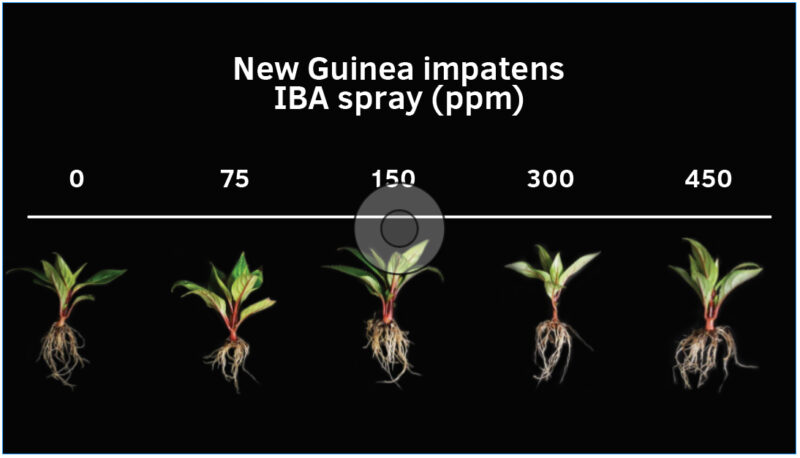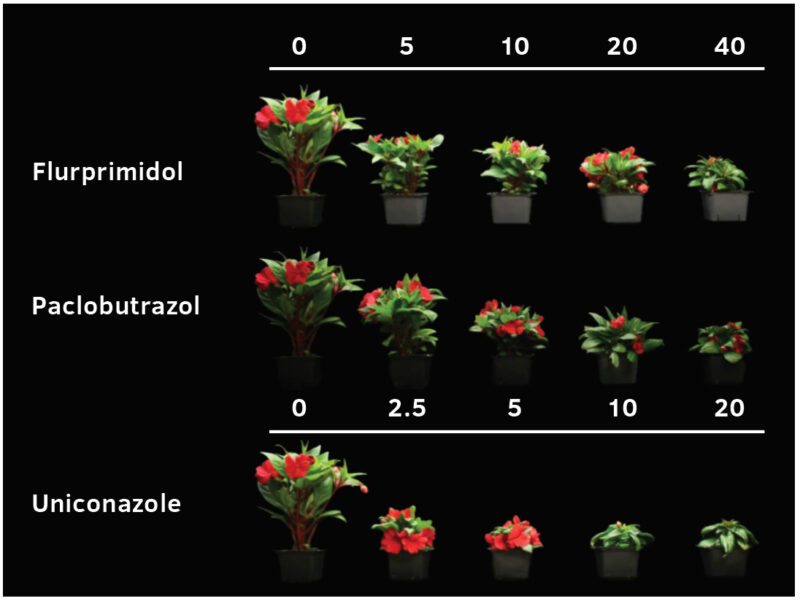Annuals and perennials
“Work smarter, not harder.” If ever there is a time to keep this mantra at the front of your mind, the spring season is it. From annual to perennial, seed to cutting to bare root, flats to 4-inch to large patio containers and hanging baskets, the spring season literally has it all — and the “to-do” lists reflect that.
Identifying opportunities to produce crops more efficiently and effectively should be every grower’s goal, and plant growth regulators (PGRs) are great tools to have in your toolbox. This article will review how PGRs can be used to improve rooting and cutting quality in propagation, suppress or promote growth, enhance branching and delay flowering of annual and perennial crops.
AUXIN
There is no denying the increasing popularity of vegetatively propagated bedding plants. The number of annuals and perennials produced from rooted stem-tip cuttings is evident when looking at what is grown in 4-inch and 1-gallon pots, as well as hanging baskets and other mixed containers. To promote uniform and timely rooting of cuttings for these species and cultivars, rooting hormones are commonly applied at sticking. The most widely used rooting hormone, indole-butyric acid (IBA), is usually suspended in a talcum powder or a liquid solution into which the basal end of cuttings are dipped in before being stuck into liner trays or, in some instances, directly into finishing containers (i.e. zonal geraniums). Newer IBA formulations now make it possible for growers to apply rooting hormone as a foliar spray to cuttings after they have already been stuck.
Why spray rooting hormone instead of using dips? Time and money. The primary advantage to using foliar sprays as opposed to basal dips is the labor savings. Although it only takes a fraction of a second to dip a cutting into rooting hormone, that adds up when thousands and thousands of cuttings arrive for sticking.

If you are new to foliar auxin sprays, don’t use concentrations recommended for dips for foliar sprays — it will likely be excessive and damage plants. Concentrations appropriate for sprays are much lower than those used for dips, as low as 80 to 400 ppm for foliar sprays compared to ≥1,000 ppm for dips.
Typically, 2 quarts of final solution are applied per 100 square feet of growing area, and this works well for foliar auxin sprays, too. However, although not necessary, applying higher volumes of auxin spray allows for runoff from the heavy application volume to end up at the base of the stem and further enhances root promotion.
GIBBERELLIC ACID INHIBITORS
Controlling plant growth and unwanted stretch is an important part of spring crop production. The most common PGRs applied to control growth are the gibberellic acid (GA) synthesis inhibitors. By reducing GA synthesis, plant cells elongate less and growth is suppressed. Ancymidol (Abide, A-Rest), chlormequat chloride (Altercel, Citadel), daminozide (B-Nine, Dazide), flurprimidol (Topflor), paclobutrazol (Bonzi, Piccolo, Paczol) and uniconazole (Concise, Sumagic) are all the different GA-inhibitors labeled for use on spring crops.
One of the biggest differences between these active ingredients is their relative strength. For daminozide sprays, 2,500 or 5,000 ppm are common and appropriate concentrations, whereas uniconazole sprays may only be a few (<5) ppm. The residual activity of these compounds also varies, with uniconazole as the longest duration of control and daminozide the most transient. Keep in mind the value of growth retardants like daminozide with shorter periods of control — these can be very useful for holding crops at the end of production without negatively impacting their garden performance for consumers.
 For many spring crops, we can also take advantage of those growth retardants, including ancymidol, flurprimidol, paclobutrazol and uniconazole, that are taken up by roots. By drenching substrate with growth retardants, longer-lasting growth control is possible. In addition to drenches, root-active compounds can be used for plug and liner dips. By placing a plug or liner tray into a PGR solution ~1/2 to 2/3 the depth of the tray and allowing it to sit for 30 seconds to two minutes, crops can get treated with growth retardants prior to planting. This is an efficient way to treat plants before they are planted out and a much lower density in the greenhouse for finishing. Additionally, liner dips are useful for treating aggressive cultivars before planting when they are mixed with less-vigorous crops in mixed containers together.
For many spring crops, we can also take advantage of those growth retardants, including ancymidol, flurprimidol, paclobutrazol and uniconazole, that are taken up by roots. By drenching substrate with growth retardants, longer-lasting growth control is possible. In addition to drenches, root-active compounds can be used for plug and liner dips. By placing a plug or liner tray into a PGR solution ~1/2 to 2/3 the depth of the tray and allowing it to sit for 30 seconds to two minutes, crops can get treated with growth retardants prior to planting. This is an efficient way to treat plants before they are planted out and a much lower density in the greenhouse for finishing. Additionally, liner dips are useful for treating aggressive cultivars before planting when they are mixed with less-vigorous crops in mixed containers together.
ETHEPHON
If you are looking for a PGR that can do several things, look no further than ethephon (Collate, Florel, Pistil). While it doesn’t slice and dice, it suppresses growth, promotes branching, aborts flowers and ripens fruits. For spring crops, ethephon is most commonly used for suppressing unwanted growth, like the anti-GA compounds already discussed. It can also be used to enhance branching on crops. This is especially useful for getting containers to fill in more quickly, enhancing quality and minimizing production time.
Ethephon is especially useful for those containers with a long production time that you want to keep vegetative early on, such as hanging baskets and mixed containers. Premature flowering is not desirable when you are bulking up the plants and spent flowers become a magnet for pathogens. But instead of pinching or shearing or handpicking, ethephon sprays help knock off buds and flowers and keep crops vegetative. Early ethephon applications for these crops pack a one-two punch, by both knocking off unwanted flowers and enhancing branching.
Anytime you use ethephon, remember all the potential effects of its application. This is especially important when trying to avoid unwanted flower abortion close to target marketing dates — you don’t want to turn your crop too green at the last minute!
Although all ethephon products are currently labeled for foliar sprays only, a new label for Collate will be coming out that expands applications to include drenches. While traditionally applied with sprays, recent research and trialing has shown that drenches are also an effective application method for ethephon. This new label will simply be putting one more tool in your toolbox.
BENZYLADENINE
One of the newer active ingredients on the market, benzyladenine (BA; Configure) is an excellent tool for improving the branching and finished plant quality of annuals and perennials. Using BA allows growers to enhance branching similar to using ethephon, but without the other side effects that may be experienced when using ethephon.
GIBBERELLIC ACID
We spend a lot of time trying to suppress GA in spring crops, but there are instances where we apply it to annuals and perennials. For some seed-propagated perennials, treating seed with GA can improve germination percentages, improving plug tray stands. Additionally, it can be used when growing topiary geraniums. Like poinsettia trees, the GA are used to help the geraniums gain height without excessively long crop times.
GIBBERELLIC ACID + BENZYLADENINE
One of the biggest concerns I hear is: “What if I use too much growth retardant?” Excessive amounts can get on plants due to a variety of errors, from calculating to mixing to application. Regardless of how it happens, the combination of GA4+7 and BA7 (Fascination, Fresco) can help overcome excessive growth regulation. Although we mentioned using GA for topiaries, GA+BA is preferred for overcoming excessive growth regulation since you are less likely to get excessive promotion with the combination. As with any over-regulation remedy, as soon as you can recognize the error and treat crops with GA+BA, the more success you’ll have turning growth around.
In addition to enhancing growth, GA+BA can also be used to reduce lower-leaf yellowing on geranium cuttings in propagation. After geranium cuttings are harvested from stock plants, packaged and transported from Central America to greenhouses across the U.S., their carbohydrate pool can get depleted. Once the cuttings are stuck and placed in the greenhouses, lower leaves start to yellow and fall off, reducing marketability and photosynthetic area, while increasing the potential for disease.
By spraying geraniums with GA+BA after they are stuck, the yellowing of lower leaves is suppressed. Between 2 and 4 ppm is a good place to start. Additionally, if you use GA+BA on geraniums, you should also use a rooting hormone, as the GA+BA can slow rooting (and the auxin promote it). However, don’t apply these as a tank mix. A spray volume of 2 or more quarts per 100 square feet may be good for auxin, but not for GA+BA on cuttings — keep the volume to 2 quarts or slightly less per 100 square feet to avoid getting runoff to the base of the cutting.


 Video Library
Video Library 




















